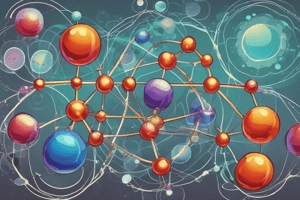Podcast
Questions and Answers
What defines the isotope of an element?
What defines the isotope of an element?
- The number of neutrons in the atom (correct)
- The number of protons in the atom
- The size of the nucleus
- The number of electrons in the atom
What distinguishes one chemical element from another?
What distinguishes one chemical element from another?
- The size of their nucleus
- The number of neutrons in their atoms
- The number of protons in their atoms (correct)
- The number of electrons in their atoms
Why is it not possible to see atoms with conventional microscopes?
Why is it not possible to see atoms with conventional microscopes?
- They are transparent to visible light
- Their size is smaller than the shortest wavelength of visible light (correct)
- They are constantly moving
- They are not composed of light-reflecting materials
What makes accurately predicting the behavior of atoms using classical physics not possible?
What makes accurately predicting the behavior of atoms using classical physics not possible?
Where is most of an atom's mass located?
Where is most of an atom's mass located?
Flashcards are hidden until you start studying
Study Notes
Atoms and Elements
- The isotope of an element is defined by the number of neutrons present in the atom's nucleus.
- Chemical elements are distinguished from one another by the number of protons present in the atomic nucleus, which is known as the atomic number.
- Atoms are too small to be visible with conventional microscopes due to the limited resolving power of light.
- It is not possible to accurately predict the behavior of atoms using classical physics because atoms do not follow classical physics rules, but rather exhibit wave-particle duality and uncertainty principle.
- Most of an atom's mass is located in the nucleus, which consists of protons and neutrons, with the electrons having negligible mass.
Studying That Suits You
Use AI to generate personalized quizzes and flashcards to suit your learning preferences.




